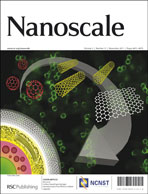Polymeric micelles with core–shell–corona architecture have been found to be the efficient colloidal templates for synthesis of periodic organosilica hollow nanospheres over a broad pH range from acidic to alkaline media. In alkaline medium, poly (styrene-b-[3-(methacryloylamino)propyl] trimethylammonium chloride-b-ethylene oxide) (PS–PMAPTAC–PEO) micelles yield benzene–silica hollow nanospheres with molecular scale periodicity of benzene groups in the shell domain of hollow particles. Whereas, an acidic medium (pH 4) produces diverse hollow particles with benzene, ethylene, and a mixture of ethylene and dipropyldisulfide bridging functionalities using poly(styrene-b-2-vinyl pyridine-b-ethylene oxide) (PS–PVP–PEO) micelles. These hollow particles were thoroughly characterized by powder X-ray diffraction (XRD), dynamic light scattering (DLS), thermogravimetric analysis (TG/DTA), Fourier transformation infrared (FTIR) spectroscopy, transmission electron microscopy (TEM), magic angle spinning-nuclear magnetic resonance (29Si MAS NMR and 13CP-MAS NMR), Raman spectroscopy, and nitrogen adsorption/desorption analyses. The benzene–silica hollow nanospheres with molecular scale periodicity in the shell domain exhibit higher cycling performance of up to 300 cycles in lithium ion rechargeable batteries compared with micron-sized dense benzene–silica particles.

You have access to this article
 Please wait while we load your content...
Something went wrong. Try again?
Please wait while we load your content...
Something went wrong. Try again?


 Please wait while we load your content...
Please wait while we load your content...